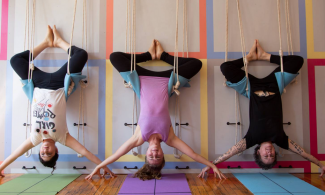
An edited version of this interview appeared in Cooperative Journal
Ebony Gustave: My name is Ebony, I am with Cooperative Journal. Today I'm interviewing a few of the worker-owners of Samamkaya Backcare and Scoliosis Collective.
Deborah Wolk: Hi, I'm Deborah Wolk, I'm the founder, program director, and a worker-owner at Samamkaya Yoga.
Catherine Murcek: Hi, my name is Cat Murcek, I am a worker-owner at Samamkaya on the faculty and I'm also on the committee that we started for co-op engagement.
Jon Musgrave: Hi, my name is Jon Musgrave, and I'm the founding manager of Samamkaya and now I'm teaching. I'm still sort of working with the management team, I'm like a help helper, I guess we can say it that way.
Coral Cohen: I'm Coral Cohen, I'm the manager at Samamkaya and a worker-owner.
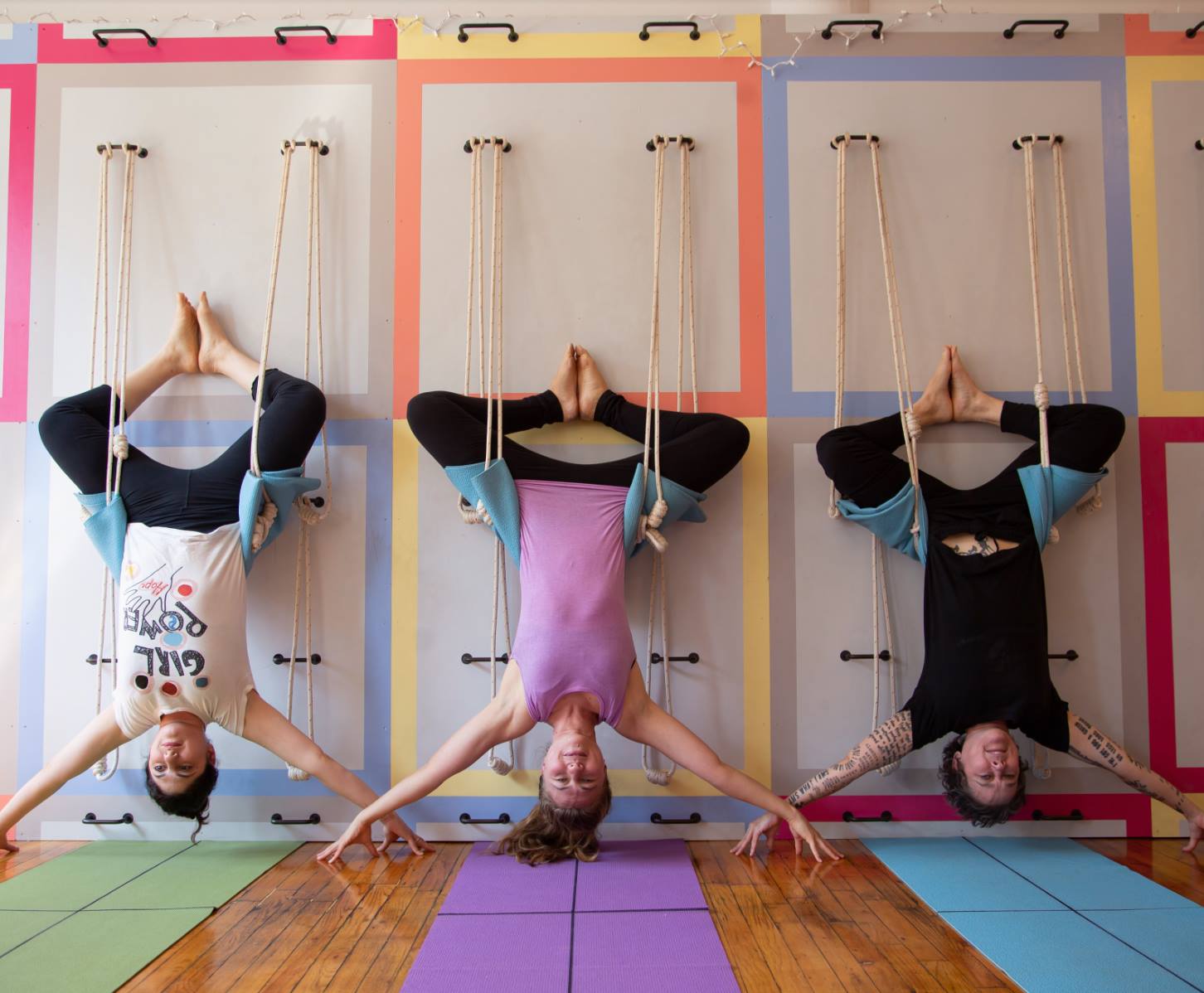
Ebony Gustave: Thank you so much for introducing yourselves and for taking the time to speak with me. So can you please share what inspired you to create a worker-owned yoga studio dedicated to those with chronic back issues?
Deborah Wolk: I'll start because I founded the studio and I definitely had a definite mission in mind and the mission of Samamkaya is really the heart of Samamkaya’s whole trajectory.
I was a student with scoliosis and when I started yoga, I experimented with lots of different styles. Over a number of years I Injured myself frequently. I was sometimes injured by teachers adjustments who didn't understand what they were looking at and I had a number of back issues. I had fallen twice from a really great height, I was also recovering from that.
Yoga was helping at first and then not at all. When I went searching for things I could do for my back or more specific yoga, I eventually found Iyengar Yoga, an alignment based yoga, which was very helpful. There were a couple of teachers who were extremely helpful and very specific about what I needed to do. But even in those types of classes, I encountered a teacher who didn't know me and didn't have the same kind of experience, or I went to classes where everyone got the same instruction. I would get hurt again, even in those methods.
So when I became a teacher, I started to teach specialized classes for scoliosis and I was encouraged by my primary teachers to do so. I started noticing there was a big demand for it and that people had gone through similar experiences to me. I needed a space that was more specific as I grew more adept at using props and using certain techniques to help my students, I needed a different kind of yoga space. I decided to start my own space and I did so at first with a business partner. It was kind of a mixed center and the danger of that was that the students would think, well, my back's all better now after a few classes and they go to regular classes and they could get hurt again.
When that partnership ended, I decided I wanted a center that was just devoted to back care and scoliosis, nothing else. That was the mission of the center and also that I would help teach teachers. There's just not enough teacher education in this area so I wanted teachers to learn how to teach this way. I also wanted teachers who were very talented with therapeutics from all over the world to meet at our center and to teach us. I really feel like that mission has been met, that's the genesis of the back care and scoliosis mission of Samamkaya.
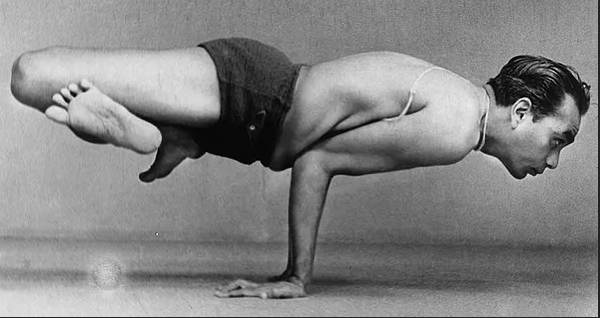
Ebony Gustave: That's amazing. I love that you started it out of a need that you found was lacking because of the issues that you had with your back. How did you raise the money to start the co-op?
Deborah Wolk: We had a little bit of a profit from the previous center so we split that profit and so that was part of my savings. Like the first center, I had a zero percent interest credit card. I used a credit card and this money was intended as a loan to the studio but I really went ahead and spent all my money as much as I could so that the center was exactly the way I wanted it. It would not only lure students in, but very senior teachers would take us seriously because we had such a good setup and that has actually come to pass.
One of my colleagues who helped me set up the studio in the beginning suggested we have an Indiegogo campaign. We had an Indiegogo campaign where students could get a class card with a discount or they could get a big unlimited card with a huge discount, or they can buy something for a friend. We sold a whole bunch of classes in advance in a way and we raised a large amount of money and it really helped the set up. Then about a year down the line that was not such a great idea. It was problematic because then people just weren't buying things and so they were just using these cards and classes that they'd already bought.
It was a mixed blessing, but it was definitely good to just kick off the whole project.
Ebony Gustave: That's also a good way to see it's like there's a need for what you're offering in the community, to have people buy in before it's actually ready
Deborah Wolk: Well, most of these people were coming from the other center. The other center had pretty much the same faculty or very similar faculty, and I brought the whole faculty over with me. Many of the students came over from the other center. Some didn't, because there's still another center, you know, where the old center was. Some go to both and some of the teachers teach at both.
Ebony Gustave: You recently allowed student members the option to join the co-op, right?
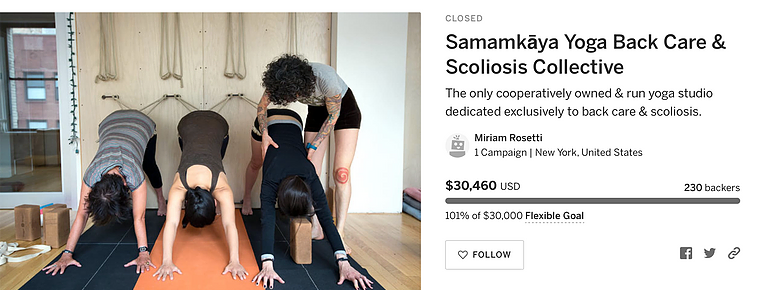
Jon Musgrave: This is its fourth year, so it must have been created in 2017, we created a student member program. Basically what that functions as is like a discount program for our most dedicated students. It's not really part of the co-op structure of our studio, in that the students that are in the student member program don't have a vote in terms of what's going on in the co-op. It has created a real sense of our studio, many of our students are students that couldn't practice anywhere else. There is a real sense of camaraderie about our studio that we wanted to then cultivate more and more. Our student member program has grown year over year every year since we started it. It is a very popular program, but like I said, they're not actively involved in the decision making.
Ebony Gustave: So for those that are involved with the decision making process, how does that process go about?
Jon Musgrave: The way that we make decisions, it all depends on where the decisions are being made. Our small decisions like day to day decisions happen with the management team that’s me, Deborah, and Coral. We make decisions sort of unilaterally as it affects the day to day workings of the studio.
Above that, if we have any choices or any decisions that need to be made on a bigger, more global level, what we do is we keep a running list of what those decisions are that need to be made. We used to have only one full member meeting per year and we increased that to two because we were finding that there was just too much of a backlog. Now we have two member meetings per year and that is when we then tackle those bigger concerns.
What we do is we - prior to the meeting - we list everything that needs to be done and then we send out an agenda for the meeting that contains both pros and cons for any particular decision that we're trying to make. At the meeting, we go through the pros and cons and then we discuss back and forth. We actually try to keep the discussion fairly short and keep meetings actionable so they don't go on forever and ever. We'll discuss a bit and then somebody will propose a solution to whatever problem it is we're trying to solve. Then the question goes out to the members and we say, does anybody object to that solution? If there is an objection to the solution, then we continue to dialog around it until we get to a point that a solution comes about where no one flat out objects to the solution. That may not be that everybody is 100 percent comfortable, but we come to an equitable solution where nobody outright objects to it, and then we move forward from there. Always with the idea that the decision can be revisited later on in the future, none of these things are set in stone.
Ebony Gustave: It seems helpful to have a sort of loose consensus so that meetings don't go on forever.
Jon Musgrave: We have 19 members and so to have 19 people in a room spending two hours, that's thirty-eight collective hours that we're spending in this meeting and that's a lot of time we're then spending. It's a big investment that we want to make sure that the things that happen in that meeting are as actionable as possible and then it doesn't just end up into a gripe session. I think focusing on that democratic way of coming to it is a nice way to focus on it because it focuses the attention on the solution rather than on the nitty gritty of the problem.
Ebony Gustave: Can you tell me a bit about the cooperative economics alliance and how that has given you support in developing and sustaining the co-op?
Catherine Murcek: The Cooperative Economics Alliance, also known as CEANYC, is really an incredible support and community that we're really fortunate to be part of. They have a program called the Solidarity Economy Giving Project that has created a lot of support and opportunities for us. Basically, every year they raise funds and every year any member of CEANYC is able to apply for a small grant of those funds to put toward a huge variety of different uses.
One use we've had for that funding that we've received is for our adaptive yoga program. We have a special class that's donation based, it’s just for people who might have certain disabilities that prevent them from being able to come to even our general backcare classes. They might be in a wheelchair or have a prosthetic limb or something so we have highly skilled teachers teaching those classes and we want we want them to be accessible. Through fiscal sponsorship with the Democracy at Work organization, we're able to support those students in that way.
We also have used the Solidarity Economy Giving Project to allow me to participate in a wonderful training program they have called the Cooperative Leadership Institute. It was a really intense five day program where I just took tons of notes and we delved into really important conversations around power dynamics, types of leadership, types of decision making, nonviolent communication and institutionalized racism. I brought that info back to our worker-owners, I shared all the notes and docs with them. We had a few meetings to help us talk about these issues and build community within our co-op.
Finally, this year, we applied again for those funds and we're able to use that to help kind of offset some of the losses that we were experiencing from the COVID-19 crisis, because we had to obviously close our physical studio space. Even though we've been able to transition to online classes, we're still not operating at the level when we were open. That has also been a huge supporter.
Being a member of CEANYC means you get a reciprocal membership with the New York City Network of Worker Cooperatives, also known as NYC NOWC. CEANYC is the kind of broader solidarity economy organization within New York City, NYC NOWC just focuses on worker cooperatives. With support from NYC NOWC, we've also benefited a lot. When Deborah and the other founders were first starting the studio, we were able to get pro bono legal assistance to help with the bylaws and to set up really most aspects of the cooperative and they also have a great program called the Principle Six Program. If you're familiar with principle six, which is cooperation among cooperatives, it allows co-ops for members to apply to get products or services from other co-ops in the network. We've been getting our business cards printed from Radix Media, which is another local co-op and because of the funding through NYC NOWC, we're able to get that for free. In addition, NYC NOWC has reciprocal membership with the US Federation of Worker Cooperatives, that's the national network for worker co-ops. Simply just by becoming a member of one of these organizations, you automatically become part of this interconnected ecosystem of enterprises and organizations who are all really passionate about this movement, about social justice and economic justice, about cooperation over competition and about planet and people over profit.
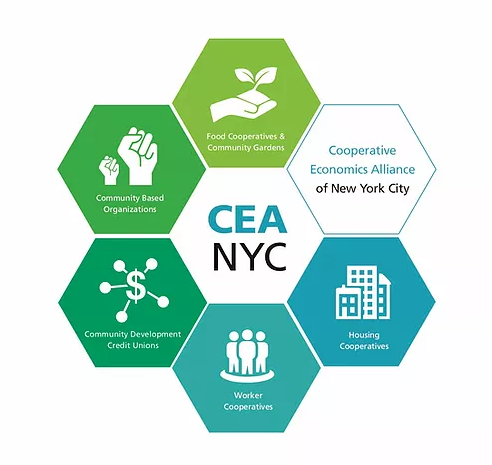
Ebony Gustave: That's amazing. I had no idea there were so many resources in New York City for worker co-ops. That's just awesome to see that there is an alliance of cooperatives, too, because I feel like that's really important in order to have cooperative models become more of a prevalent thing and to just support each other and build more resilience among the network of cooperatives.
You mentioned something about having a donation based class but how have you framed your model so that student and worker members are satisfied with the normal price that you offer?
Jon Musgrave: We actually use a much more traditional model in terms of how we came about our pricing in that we are looking at the other studios in our area that are offering close to the level of teaching and also the level of space in terms of the props and everything. These are the other studios that are sort of at our similar level so how do our prices compare to them? We're trying to stay competitive but level with those studios.
When we transitioned online, we actually took a different approach. Most of the classes that are happening online right now are happening with basically an unlimited number of students. There are some teachers and very senior teachers in the world who are teaching to four to five-hundred people in a classroom. Because of that, there is no or very minor individual instruction in those classes. In our classes and in our studio, we're working with students for whom those kinds of classes are just not something that they would or potentially could do at all. We have limited our class size so that we don't have more than a single page on Zoom. Even then, Zoom can have twenty-five people on a screen and we're not teaching to that level. We're keeping our class sizes small and we're giving very individualized attention in every class. Because of that, we chose to price our individual classes higher.
The other thing that we did is that we made weekly and monthly unlimited cards that when you end up figuring out how much people are paying per class with those unlimited cards, they're paying much less than our drop in fee. We knew that most of the people who are coming to class are going to use this opportunity to take a lot of yoga and that's actually been true. We've got one student that is taking at least two classes a day. So she's taking like 14 or 15 classes every week and she's paying two hundred dollars for the month. We knew that a lot of our students weren't going to be paying our full drop in price.
The other thing that we then did is that we instituted a policy and this is a policy that we've always had, we don't turn away students, we've never turned away students. Students that for whatever reason, don't have the ability to pay, we've worked with them to figure that out. We have just instituted a policy that says if you can't afford to pay, tell us what you can afford and that's what you'll pay for class. We have also instituted a donation program from our other students. We have some students that are paying quite a lot of money into the studio and other students that are paying just 10 dollars here, 20 dollars there and with that fund of money, when people can ask us to take a discounted or free class, that's offsetting.
Particularly right now where so many people are out of work, that was a really important job. We don't want to create a situation where our pricing excludes people so we're very upfront about the fact that if you can't pay, then please let us know and we'll figure out something.
Ebony Gustave: I think it's amazing that you guys do that, especially for something that is a chronic issue for a lot of people. While they may get turned away from the health care system because they can't afford that, at least they have another outlet for support. So what kind of support do you offer students at a traditional yoga studio or physical therapy session cannot?
Jon Musgrave: Traditional yoga studios or I'd like to substitute the word typical, because yoga is a tradition that has changed vastly in the last hundred years. In terms of more typical studios, what we're offering, I think is twofold.
One is that, like Deborah was saying before, our teachers are very skilled at teaching specifically therapeutic yoga for people with back issues, scoliosis, and then the other joint issues that happen in the limbs because of that. There are a couple of our teachers who don't have a particular issue, they just are therapists at heart but I would say 75 to 80 percent of our teachers are people who either came to yoga because of their back issues or are continuing to or using yoga actively to help with their back issues. That personal level of knowledge about the practice, I think is a really big aspect.
In a regular yoga studio, they may have some blocks and straps or something but we in addition to that, have a whole host of props. We have a rope wall, bolster, chairs, and wedges and other things that we're using to modify the practice and to be able to make it accessible to people who can't just be on the floor and doing this in a sort of typical yoga studio fashion.
In terms of physical therapy, the way that physical therapy is practiced in the United States is that, (this is especially true if you are working through insurance) if you have a issue on your right knee, you're going to go to a physical therapist and they are going to work exclusively on your right knee, primarily through exercise. If you get a good one, they may also be doing some manual work, but they're not necessarily and in a lot of cases are not at all going to be working on even your right ankle and your right hip, let alone your left leg, let alone your spine, let alone what's happening elsewhere in your body. The practice that we're doing is a holistic practice that looks at the entire body, not just the one joint. There are wonderful physical therapists who don't work in that fashion but I think the physical therapy industry as a whole works in that way. It's just not necessarily the best option for long term care. Like you said before, many of our students are coming to us with longstanding back to longstanding joint issues, physical therapy is just not necessarily well equipped to handle.
Ebony Gustave: I could imagine that being a bit intimidating for someone with chronic back issues to go to a typical yoga class as well, because they may not be getting that individualized attention and they're looking at other people and what they can do and not really getting the support for their needs.
Jon Musgrave: In addition to that, the more traditional, particularly Vinyasa practice, is actually not set up well. It's not only the studio and it's not only the environment, but it's also the practice itself that, going from deep forward bends to deep backbends over and over again for somebody with disc issues on their spine, for somebody with scoliosis is actually the practice itself that is not particularly supportive of the student. In addition to the two things that I mentioned in terms of the props and the teaching, it's also the fact that we're teaching the poses in sequencing. How we sequence the poses and how we teach the poses is going to be a fundamentally different concept than in a more typical yoga studio.
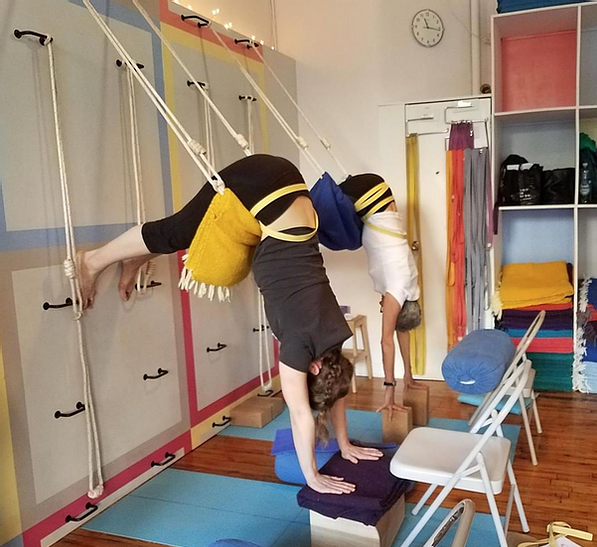
Coral Cohen: If I can add something small, just as a student, I was doing a lot of more typical yoga vinyasa for a long time, and I really liked it, it felt great but as someone with scoliosis, it was not helping. It was actually sometimes making it worse because what feels good to someone with scoliosis often is what is in their pattern. You can actually exacerbate some of some scoliosis with vinyasa yoga. Not that it's like bad or anything, for some people it's really great, but for me it was I was doing things, I was stretching and I was doing things that felt great but were not helping and in some cases making my issues worse. When I came to Samamkaya, I really started to understand how to counteract that and actually understand what was going on in my body in a way that helped me build strength rather than just stretching out my limbs, which for a lot of people with scoliosis is actually not helpful.
Ebony Gustave: It's very interesting, so what kind of yoga do you guys integrate into the Samamkaya classes?
Catherine Murcek: There's not like a trademarked name for it, most of our teachers have a lot of training in Iyengar Yoga. The props and the style of the sequencing and the alignment cues are very much related to Iyengar, but it's definitely not Iyengar specific. Many of the teachers are not certified in Iyengar yoga, it's definitely something different. There's another teacher based in California who runs yoga for scoliosis specific program. A lot of us have done training with her, Elise Browning Miller. That's why we call our classes yoga for backcare or yoga for scoliosis. We haven't taken a style name for ourselves and trademarked it and promoted it, we're really just drawing from multiple traditions. Each teacher has their own strengths and their own knowledge bases. A couple of our teachers are physical therapists, one of them is an occupational therapist. Jon and a couple others are massage therapists. I have a background in dance and a couple of us have some background in Alexander technique. There's a wide variety of different therapeutic modalities that we infuse the practice with so it's a fusion and something of it on its own.
Deborah Wolk: The initial founding faculty I handpicked for their skills and talents, innate talents and therapeutics, and as Cat said a lot of the teachers also have body work backgrounds. Some of us have studied with Bonnie Bainbridge Cohen, who does body mind censoring. I wanted a mixture of ideas because I'm always looking for people to share ideas but I wanted everything also to be very safe for the students who came. In the beginning, there were more Iyengar teachers and now there's fewer but I feel like there's more ideas. We're all very well integrated with each other, we all complement each other.
Ebony Gustave: I think that's really cool that you guys also have backgrounds in things like massage and dance because you really understand the anatomy and what feels good as well. So for people that don't have chronic back issues, but now in modern society, we spend so much of our day looking down at our cell phone, how important is it for us to protect our spine?
Catherine Murcek: It is even if you don't have chronic back issues, it is still extremely, extremely important to be taking measures to protect your spine. I'll just share a statistic I found on the web because back issues are kind of like a silent epidemic in our society. About 50 percent of working Americans admit to some level of back pain every year and experts estimate about 80 percent of Americans will experience a back issue at some point in their lives. That's a huge, huge portion of the population. I honestly think that those numbers could actually be higher in reality, because even if someone doesn't admit to having back pain, so many people you can think of that have a tense neck or like a shoulder or a hip ache, and those are all related. I think the percentages are probably actually more.
Protecting the spine is absolutely imperative because that's the center, that's our literal backbone of the body. We all tend to take our backs for granted and we don't really think about it until it starts hurting. Anyone who's had major back pain before can tell you that if you are having major pain, it's extremely debilitating because not only can you barely move because any movement is centered in the spine so it's probably going to hurt, but also pain itself is exhausting. Not only can you not move around as much, but you're exhausted from the pain.
Even the habit of slouching, if you slouch - I know I do a lot in a head forward position, these things prevent our bodies from being able to operate properly, it prevents your breathing or your digestion. When you can't function your best, you don't feel your best and so for those reasons, it's really super important.
I think that in our society and Western medicine in general, they tend to not really address an issue until it becomes an emergency because preventative measures are not really as profitable. For example, before I started doing yoga for backcare, I used to get these horrendous neck spasms. It would just lock up and be so painful that I could barely turn my head, I could barely lie down and get up. I knew I was just going to be flat on my back for days until it calms down. Most of the time, if I went to a regular doctor, I would walk away with a prescription for muscle relaxants and maybe if I was lucky, a few weeks of physical therapy. That is just not sustainable and it's not forward thinking.
What we do in our studio as Jon was saying, we take the body from a holistic approach. It's not just about the musculoskeletal system, but it's also about our breathing and our nervous systems. We are literally reeducating the body. We're trying to repattern neuromuscular pathways by asking the students to really tune in and become keenly aware of their habits and execute causes and movements with more consciousness. By teaching our students how they can most efficiently move and hold themselves throughout their daily lives, we're empowering them to be able to prevent and more quickly alleviate pain on their own.
Jon Musgrave: The one thing I would like to add to what Cat said is that a particular crisis that is happening right now because back pain is epidemic in our culture, in addition to muscle relaxants, one of the primary ways that Western medicine has been treating us is through opioids. We know now, how detrimental that has been to society, that opiate addiction is a huge problem and is very challenging to get out of. All these things that we're talking about in terms of neuromuscular rehabilitation is just super important in terms of getting people out of the habit of chronic pain, the cycle of chronic pain that otherwise ends up just getting masked over with painkillers.
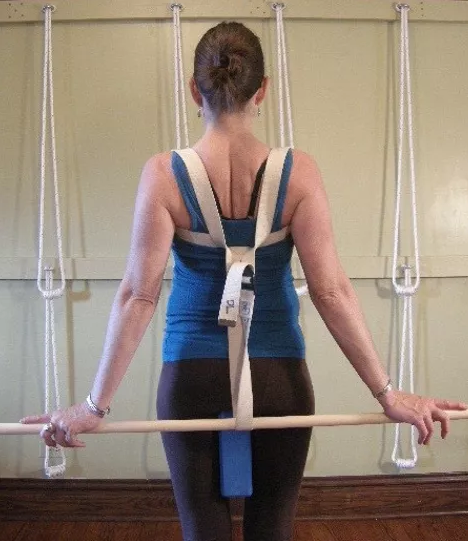
Ebony Gustave: Thank you for that. Thank you for building that connection of our entire body to our spine, which I think we take for granted. All of you guys can answer these if you would like, so what is the greatest challenge in nurturing a worker owned yoga studio?
Jon Musgrave: I think at the beginning, you know, the first couple of meetings, it was just establishing the democratic mindset. Most people are used to working in a very hierarchical system where you go to a meeting and you're told by your boss what you're going to be doing, there's almost no dialog. Then you leave like meetings are a way to disseminate information, not to have discussion. At the beginning, the challenge was to get our teachers to participate at all in what was going on.
Now I think our challenge, it's a related challenge, but I think a lot of our teachers specifically are very easygoing, they're happy with whatever is going on, whatever the consensus is, they're fine with. Just getting them to actually engage with the process is a little bit hard. It's hard to know what some of our teachers actually think because when they come to meetings they don't say anything. It's also because of the nature of our studio, we're a very small studio, we don't have a front. Our staff and our teachers are only there when they teach. So because of that, unless somebody happens to have classes that are close enough together that you're overlapping, that someone is leaving when somebody else is coming in, our teachers just don't see each other. Basically, the only time that all of our teachers are together and that we are there as a group is when we get into these meetings. If some of our teachers are only teaching an hour a week or an hour and a half a week, engaging them in the idea that even though you're only here an hour and a half a week, that we value your opinions, we want this studio to work well for you, not just well for us and not just well for the studio, we want the whole community to be engaged. It can be a little bit challenging.
In terms of the greatest benefit, I mean, I think the greatest benefit is the versatility and the adaptability because you have all of these people with various skills, yoga and managerial and otherwise, it means that it's not just up to those of us on the management team to get things done, that there are other people that have these skills that can compliment what everybody else is doing.
This was particularly helpful when the coronavirus hit. We had a week where we were trying to figure out how we could have reduced class sizes and then we decided that we were going to close the studio. Two days later, NYC said your studio has to be closed. Between that Tuesday, when NYC told us that we have to be closed, we only had six days before we were up and running online. That was made possible entirely from the fact that we had 19 people that we could spread the work around and there were, I think, five or six people that were instrumental in getting up online. If it had just been up to me, Carol and Deborah getting up online, it would have taken a lot longer for it to happen just because there were only so many hours and we were all going through so much at that time.
Deborah Wolk: A lot of my feelings are the same as Jon, I'd say for me the greatest challenge, because I had been a co-owner before and I had a partner. My feeling was, if something is not getting done I have to do it, or if there's not enough money I have to throw money at it, or if something has to happen, it's going to be me. That was still my attitude going in, because, as Jon said, the teachers were a little bit passive. They were a little bit happy with whatever was going on, they all sort of followed me over there.
Over time, as I began burning out and not being able to do everything, people started really stepping in and helping me out and so that's the greatest benefit. The thing I love most about being a co-op is that the work is collaborative. Before I was a yoga teacher, I was an artist and I did all collaborative work with performance groups and I loved working that way. I don't have trouble working with others usually.
I have a board of directors if something's going wrong I can go sound off on them. All of the teachers and members have formed committees to help me out, there's a co-op committee, adaptive yoga committee, advanced studies committee, financial committee, and there was a marketing committee for a minute. They all have stepped in so that they take the load off of me and now I truly am just the program manager. I'm not trying to manage every single little detail and that's made me a much happier person than I was when I had to try to micromanage everything.
Catherine Murcek: I basically just want to echo what Jon and Deborah were saying, I think, yes, the biggest challenge sometimes is infusing collaborative culture in the business because most yoga teachers are used to being 1099 independent contractors, once in a while they get their W-2. For most people or teachers, you're kind of going from studio to studio and just doing your thing and you're not really a part of the business. So really trying to get people to take ownership of this studio and understand that this is your studio and it's survival depends on everybody's commitment to it can take some time for people to really sink their teeth into.
We started just recently requiring a work requirement, minimum number of hours. I think it's like 10 hours a year or something like that but just to make sure that every worker-owner in a studio is contributing in some way, whether it's as part of a committee or doing cleaning in the studio, something so that we're all contributing.
Benefits are similar, I love how collaborative it is. I love how we all really respect and trust each other. The way that we all came together when the lockdown first began was really inspiring and it felt really cool to be part of this community. Kind of like what I was saying earlier, it's been incredible to be part of this greater worker cooperative movement. Through the movement, I have been getting more involved in community organizing and advocacy for worker cooperatives because I became so inspired by this model. We're very fortunate that in New York City, we have a certain amount of funding that through NYC NOWC, I'm able to get small stipends to do this work for the movement. So in that way, I can connect with the broader co-op community, which puts Samamkaya’s name out there. We're working on things like creating a community wide brand for New York City co-ops so we can all help promote each other. There are always lots of advocacy efforts going on. It has really, really changed my life for the better. I have to say, I'm not just a yoga teacher anymore, I'm also really involved in something that I really see as potentially having potential to change the world for the better.
Coral Cohen: I think the same, the greatest challenge is just getting people involved. Like everyone said, everyone's really easy going, but then they will have opinions here and there. Getting them to actually contribute to making those things happen has been a bit of a challenge. Specifically because my job as manager is sometimes I find that someone will suggest we should put this idea into practice. It's like, OK, well, who's going to do that? Basically what you're saying is that I have to do that. Generally people have been really great about trying to figure out ways to put things into practice.
The greatest benefit is just that people are always contributing. Like everyone said, when everything happened, it was really a big shock. There was a lot of work to be done and everyone really stepped up in a way that I was really surprised to see and was really grateful for because it was just a lot of work and we did it. I was very, very grateful to everyone who helped.
Jon Musgrave: I guess the other thing I would add on is that our particular problem of engagement is actually kind of a unique one when we talk to members of other cooperatives or when we've had consultations with solidarity economy and co-op trainers and things, they've been a little perplexed by that. I think most people who join co-ops, like one of the big co-ops here in the city, is an accounting co-op and they don't struggle to have engagement. I think part of it is that until recently, they're all sitting in the same place so meetings are happening once or twice a week. If you need to engage with people, it’s as simple as walking over across the hall. I just wanted to say that as much as all four of us pointed out that one of our problems is engagement, that's not actually a typical cooperative problem. It's just sort of just the nature of our business because we're not in the same place at the same time. Almost never.
Coral Cohen: I want to piggyback off that as well, scheduling is a huge issue because everyone's schedule is so different. All the teachers are teaching at multiple studios. They're teaching schedules are really, really different. Currently it's my only job but when the world was how it was before, it was not my only job. Everyone had to make time for cooperative business and it's not easy. I mean, it's a very fast paced world. I hope that that changes now that we have a lot more time but especially in New York, it's very fast paced. People are working a lot, doing a lot, have a million things going on. It's not easy to dedicate time to a business as much as you want to, but I really do appreciate how much people do, even though that is the case.
Catherine Murcek: I wanted to add one more thing, if that's okay, piggybacking off of what Carol said about when everybody stepped up when the lockdown first began, I also think that that was a real testament to the resiliency of worker cooperatives because of the model. I don't want to say this is true across the board, but in my personal experience, our studio has seemed to fare better than some of the other studios that I'm aware of. There are studios all across the country that are either closing their doors permanently or they're letting go of teachers or teachers are being furloughed and just hanging out, waiting for classes to start up again, or class sizes have gone down and pay has gone down. I think that compared to more traditionally structured yoga studios, we're pretty well off.
Ebony Gustave: Thank you all so much for sharing that. Yeah, it's definitely a different dynamic in New York City alone to think kind of collectively. Especially in a job setting that is more so, I guess, entrepreneurial but the teachers are working collectively at different times. That is really an interesting challenge. Knowing what you know now, what advice would you have given yourself when you first joined the collective?
Jon Musgrave: I have always thrived in environments which are collective. For people who know me, I don't think that anybody would argue with the fact that I'm a very opinionated person. I dislike intensely working situations where I have no voice and where my voice is really stumble down upon, I have not traditionally lasted long in those jobs. I sort of fell into this position and I've liked it from the very beginning. This idea that I have a voice in what's going on and that everybody is working collaboratively and the camaraderie that then comes out of that, I think is really great. This is exactly the kind of environment that I like and that I try to promote in everything else that I do.
Catherine Murcek: Similarly to John, actually, I've always thrived more in more collaborative environments, especially in arts and dance making. I think that my advice to my past self would be, “don't think this is just another yoga teaching gig, get ready for an inspiring life transformation.” I just kind of fell into the teaching position because a friend of mine was giving up the class and I already knew most of the teachers at the studio. It seemed like a good, logical fit. I was well versed in yoga for backcare by that time, and I remember Jon giving me the documents saying this is a co-op, you're going to be on a six month probation. I was like, okay, sure, sure. It didn't really sink in how different that was until it was a combination of things after being with the co-op for a little while. That was also 2016, the first year Bernie Sanders was running for president and I was also just starting to listen more and learn more about Marxism and worker co-ops. It all kind of clicked for me that year and really set me on an interesting new path that I'm excited about.
Deborah Wolk: When one of my colleagues recommended this co-op structure to me because they had connected with Chris, who was the representative from NYC NOWC who helped us set up the studio, and that was the first gift. I didn't realize then what I was getting and he just kept helping and helping and helping. Then I was in Berkeley and a friend of mine handed me this paper called Positive News. She said, “have you ever read positive news?” I said, “what is positive news?” I opened it up to the middle and it said million dollar grants to co-ops in the United States. I called this guy Chris as a joke and I said, “where is this million dollar grant? I want it.” He said, “you're getting it. I'm your million dollar grant. I'm part of this million dollar grant that came to New York and is being distributed through my work.”
That was the beginning of the gifts, we've met so many people who have given us pro bono work, who've given us business support, who have given us grants, and then all my colleagues who I work with and some of them have given me so much. Even the ones who were in the woodwork, like when coronavirus happened, everybody came out and helped. I just needed in the beginning to really trust the process because I didn't know how much I was going to get.
Coral Cohen: I would tell myself you're going to become so much more invested emotionally, also financially, but emotionally in the business. I didn't really realize I didn't really know much about the co-op model when I started, I was just looking for some extra work. I'm a small business owner and I say that proudly and I feel ownership over the business. Having the responsibility and the trust of my fellow co-owners to make decisions is something that I haven't really had at any other job, which can be a little bit intimidating, but I feel like I've learned how to do that. I feel like I've grown a lot as a person just through this job, just learning how to deal with different kinds of people. Also, how really invested I was going to be in the business, in the students, in the teachers, in the programs and I really can't imagine my life without the studio.
When the coronavirus happened, I was like, oh, my God if this ends, I'm going to be so upset. lt really made me appreciate what Samamkaya has given to me both as a student and as a worker-owner and how much I cared and how much I could give as well and how resourceful I could be because I cared.
Ebony Gustave: Thank you all so much for sharing. It's definitely different being a part of a cooperative and speaking to people that have that sort of mindset because they're just so willing to share information, willing to help and the brunt of the work is not relied upon you solely. There's this awesome Steve Jobs quote that says that you can't connect the dots looking forward, you can only connect them looking backwards. I think that that's really relevant in all of the stories that you guys shared, that being a part of the collective was very timely. Everything aligned so that you could learn what you needed to learn at that point in your journey and now. So thank you guys so much for taking time to be interviewed by me. I really appreciate it. Thank you so much.
All: Thank you, Ebony. Thank you. Have been great. Thanks for inviting us this. Awesome.

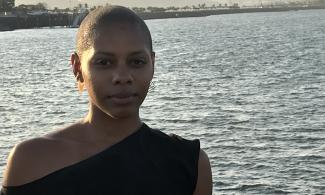


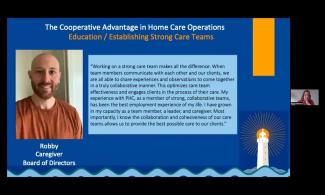
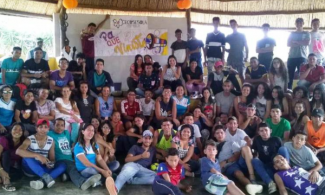
Add new comment